Improved Design via Simulation of Micro-Modified PVDF and Its Copolymer Energy Harvester with High Electrical Outputs
Abstract
1. Introduction
2. Simulation Model Settings
2.1. Material Properties
2.2. Constitutive Equations
2.3. Mesh and Boundary Condition
2.4. Vertical Load Model
2.4.1. Device Structure
2.4.2. Loading Settings
2.5. Periodical Changing Load Mode
2.5.1. Device Settings
2.5.2. Loading Settings
3. Result and Discussion
3.1. Vertical Load Mode
3.1.1. Experiment Verification
- (1) Fabrication of piezoelectric nanogenerators
- (2) Characterization
- (3) Experimental results
3.1.2. Simulation Result
3.1.3. Simulation Result Discussion
3.1.4. Parameters Improvement Based on Cylinder Structure
- (1) The relationship between radius and the voltage output
- (2) The relationship between the distance of the cylinder and the voltage output
- (3) The relationship between height (depth-to-width ratio) and voltage output
- (4) The relationship between loading force and voltage output
3.2. Periodical Changing Load
3.2.1. Simulation Result
3.2.2. Simulation Result Discussion
3.2.3. Electrical Loading Circuit Properties
- (1) The suitable resistance
- (2) Synchronization of current and voltage
- (3) The relationship between loading speed and current
- (4) Time delay property
4. Conclusions
Author Contributions
Funding
Acknowledgments
Conflicts of Interest
References
- Shah, D.; Maiti, P.; Gunn, E.; Schmidt, D.F.; Jiang, D.D.; Batt, C.A.; Giannelis, E.P. Dramatic Enhancements in Toughness of Polyvinylidene Fluoride Nanocomposites via Nanoclay-Directed Crystal Structure and Morphology. Adv. Mater. 2004, 16, 1173–1177. [Google Scholar] [CrossRef]
- Li, W.; Meng, Q.; Zheng, Y.; Zhang, Z.; Xia, W.; Xu, Z. Electric energy storage properties of poly(vinylidene fluoride). Appl. Phys. Lett. 2010, 96, 192905. [Google Scholar]
- De Neef, A.; Samuel, C.; Stoclet, G.; Rguiti, M.; Courtois, C.; Dubois, P.; Soulestin, J.; Raquez, J.-M. Processing of PVDF-based electroactive/ferroelectric films: Importance of PMMA and cooling rate from the melt state on the crystallization of PVDF beta-crystals. Soft Matter 2018, 14, 4591–4602. [Google Scholar] [CrossRef]
- Liu, Y.Z.; Hao, Z.W.; Yu, J.X.; Zhou, X.R.; Lee, P.S.; Sun, Y.; Mu, Z.C.; Zeng, F.L. A high-performance soft actuator based on a poly(vinylidene fluoride) piezoelectric bimorph. Smart Mater. Struct. 2019, 28, 055011. [Google Scholar] [CrossRef]
- Liu, Y.; Huang, Z.; Gao, Y. A Three-Dimensional and Bi-objective Topological Optimization Approach Based on Piezoelectric Energy Harvester. Appl. Sci. 2020, 10, 6772. [Google Scholar] [CrossRef]
- Karan, S.K.; Mandal, D.; Khatua, B. Self-powered flexible Fe-doped RGO/PVDF nanocomposite: An excellent material for a piezoelectric energy harvester. Nanoscale 2015, 7, 10655–10666. [Google Scholar] [CrossRef] [PubMed]
- Fan, F.-R.; Wang, Z.L.; Wang, Z.L. Flexible triboelectric generator. Nano Energy 2012, 1, 328–334. [Google Scholar] [CrossRef]
- Jain, A.; Sharma, A.K.; Jain, A. Dielectric and piezoelectric properties of PVDF/PZT composites: A review. Polym. Eng. Sci. 2015, 55, 1589–1616. [Google Scholar] [CrossRef]
- Mohammadi, B.; Yousefi, A.A.; Bellah, S.M. Effect of tensile strain rate and elongation on crystalline structure and piezoelectric properties of PVDF thin films. Polym. Test. 2007, 26, 42–50. [Google Scholar] [CrossRef]
- Murayama, N.; Nakamura, K.; Obara, H.; Segawa, M. The strong piezoelectricity in polyvinylidene fluroide (PVDF). Ultrasonics 1976, 14, 15–24. [Google Scholar] [CrossRef]
- Useberschlag, P. PVDF piezoelectric polymer. Sens. Rev. 2001, 21, 118–126. [Google Scholar] [CrossRef]
- Liu, Y.; Zhang, H.; Yu, J.X.; Huang, Z.Y.; Wang, C.; Sun, Y. Ferroelectric P(VDF-TrFE)/POSS nanocomposite films: Compatibility, piezoelectricity, energy harvesting performance, and mechanical and atomic oxygen erosion. RSC Adv. 2020, 10, 17377–17386. [Google Scholar] [CrossRef]
- Kakimoto, K.-I.; Fukata, K.; Ogawa, H. Fabrication of fibrous BaTiO3-reinforced PVDF composite sheet for transducer application. Sens. Actuators A Phys. 2013, 200, 21–25. [Google Scholar] [CrossRef]
- Park, Y.J.; Kang, Y.S.; Park, C. Micropatterning of semicrystalline poly(vinylidene fluoride) (PVDF) solutions. Eur. Polym. J. 2005, 41, 1002–1012. [Google Scholar] [CrossRef]
- Ray, S.; Easteal, A.J.; Cooney, R.P.; Edmonds, N.R. Structure and properties of melt-processed PVDF/PMMA/polyaniline blends. Mater. Chem. Phys. 2009, 113, 829–838. [Google Scholar] [CrossRef]
- Wu, H.; Chen, Y.; Chen, Q.; Ding, Y.; Zhou, X.; Gao, H. Synthesis of Flexible Aerogel Composites Reinforced with Electrospun Nanofibers and Microparticles for Thermal Insulation. J. Nanomater. 2013, 2013, 375093. [Google Scholar] [CrossRef]
- Brown, L.F.; Mason, J.L. Disposable PVDF ultrasonic transducers for nondestructive testing applications. IEEE Trans. Ultrason. Ferroelectr. Freq. Control 1996, 43, 560–568. [Google Scholar] [CrossRef]
- Foster, F.; Harasiewicz, K.; Sherar, M. A history of medical and biological imaging with polyvinylidene fluoride (PVDF) transducers. IEEE Trans. Ultrason. Ferroelectr. Freq. Control 2000, 47, 1363–1371. [Google Scholar] [CrossRef]
- Hilczer, B.; Kułek, J.; Markiewicz, E.; Kosec, M.; Malič, B. Dielectric relaxation in ferroelectric PZT–PVDF nanocomposites. J. Non-Cryst. Solids 2002, 305, 167–173. [Google Scholar] [CrossRef]
- Platte, M. PVDF ultrasonic transducers. Ferroelectrics 1987, 75, 327–337. [Google Scholar] [CrossRef]
- Hsu, C.-Y.; Liu, R.-J.; Hsu, C.-H.; Kuo, P.-L. High thermal and electrochemical stability of PVDF-graft-PAN copolymer hybrid PEO membrane for safety reinforced lithium-ion battery. RSC Adv. 2016, 6, 18082–18088. [Google Scholar] [CrossRef]
- Kim, K.-S.; Park, S.-Y.; Choi, S.; Lee, H. Ionic liquid–polymer gel electrolytes based on morpholinium salt and PVdF(HFP) copolymer. J. Power Sources 2006, 155, 385–390. [Google Scholar] [CrossRef]
- Li, H.; Kim, H. Thermal degradation and kinetic analysis of PVDF/modified MMT nanocomposite membranes. Desalination 2008, 234, 9–15. [Google Scholar] [CrossRef]
- Ducrot, P.-H.; Dufour, I.; Ayela, C. Optimization of PVDF-TrFE Processing Conditions for the Fabrication of Organic MEMS Resonators. Sci. Rep. 2016, 6, 19426. [Google Scholar] [CrossRef]
- Liu, X.; Meng, X.; Wu, J.; Huo, J.; Cui, L.; Zhou, Q. Microstructure and properties of novel SPEEK/PVDF-g-PSSA blends for proton exchange membrane with improved compatibility. RSC Adv. 2015, 5, 69621–69628. [Google Scholar] [CrossRef]
- Magistris, A.; Mustarelli, P.; Parazzoli, F.; Quartarone, E.; Piaggio, P.; Bottino, A. Structure, porosity and conductivity of PVdF films for polymer electrolytes. J. Power Sources 2001, 97, 657–660. [Google Scholar] [CrossRef]
- Chi, Q.; Ma, T.; Zhang, Y.; Chen, Q.; Zhang, C.; Cui, Y.; Zhang, T.; Lin, J.; Wang, X.; Lei, Q. Excellent Energy Storage of Sandwich-Structured PVDF-Based Composite at Low Electric Field by Introduction of the Hybrid CoFe2O4@BZT–BCT Nanofibers. ACS Sustain. Chem. Eng. 2017, 6, 403–412. [Google Scholar] [CrossRef]
- Yang, C.; Song, H.; Liu, D. Effect of coupling agents on the dielectric properties of CaCu3Ti4O12/PVDF composites. Compos. Part B Eng. 2013, 50, 180–186. [Google Scholar] [CrossRef]
- Hu, P.; Shen, Y.; Guan, Y.; Zhang, X.; Lin, Y.; Zhang, Q.; Nan, C.-W. Topological-Structure Modulated Polymer Nanocomposites Exhibiting Highly Enhanced Dielectric Strength and Energy Density. Adv. Funct. Mater. 2014, 24, 3172–3178. [Google Scholar] [CrossRef]
- Dorey, R.; Whatmore, R.W. Electrical properties of high density PZT and PMN–PT/PZT thick films produced using ComFi technology. J. Eur. Ceram. Soc. 2004, 24, 1091–1094. [Google Scholar] [CrossRef]
- Senthilkumar, R.; Sridevi, K.; Venkatesan, J.; Annamalai, V.; Vijaya, M.S. Investigations on Ferroelectric PZT-PVDF Composites of 0–3 Connectivity. Ferroelectrics 2005, 325, 121–130. [Google Scholar] [CrossRef]
- Zhou, W.; Zuo, J.; Ren, W. Thermal conductivity and dielectric properties of Al/PVDF composites. Compos. Part A Appl. Sci. Manuf. 2012, 43, 658–664. [Google Scholar] [CrossRef]
- Wang, X.; Yang, B.; Liu, J.; Zhu, Y.; Yang, C.; He, Q. A flexible triboelectric-piezoelectric hybrid nanogenerator based on P(VDF-TrFE) nanofibers and PDMS/MWCNT for wearable devices. Sci. Rep. 2016, 6, 36409. [Google Scholar] [CrossRef] [PubMed]
- Rashmi, K.; Rao, A.S.; Jayarama, A.; Pinto, R. Piezoelectric P(VDF-TrFE) micro cantilevers and beams for low frequency vibration sensors and energy harvesters. Sens. Actuators A Phys. 2019, 295, 574–585. [Google Scholar] [CrossRef]
- You, S.; Zhang, L.; Gui, J.; Cui, H.; Guo, S. A Flexible Piezoelectric Nanogenerator Based on Aligned P(VDF-TrFE) Nanofibers. Micromachines 2019, 10, 302. [Google Scholar] [CrossRef]
- Rashmi, K.; Rao, A.S.; Satyanarayan; Shastrimath, V.V.D.; Jayarama, A.; Pinto, R. Simulation and analysis of P(VDF-TrFE) cantilever-beams for low frequency applications. Mater. Today Proc. 2020, 2, 698. [Google Scholar] [CrossRef]
- Qin, W.; Li, T.; Li, Y.; Qiu, J.; Ma, X.; Chen, X.; Hu, X.; Zhang, W. A high power ZnO thin film piezoelectric generator. Appl. Surf. Sci. 2016, 364, 670–675. [Google Scholar] [CrossRef]
- Jeong, C.K.; Lee, J.H.; Hyeon, D.Y.; Kim, Y.-G.; Kim, S.; Baek, C.; Lee, G.-J.; Lee, M.-K.; Park, J.-J.; Park, K.-I. Piezoelectric energy conversion by lead-free perovskite BaTiO3 nanotube arrays fabricated using electrochemical anodization. Appl. Surf. Sci. 2020, 512, 144784. [Google Scholar] [CrossRef]
- Zurkinden, A.; Campanile, F. Martinelli. In Proceedings of the COMSOL Users Conference, Grenoble, France, 14 June 2007. [Google Scholar]
- Choi, M.; Murillo, G.; Hwang, S.; Kim, J.W.; Jung, J.H.; Chen, C.-Y.; Lee, M. Mechanical and electrical characterization of PVDF-ZnO hybrid structure for application to nanogenerator. Nano Energy 2017, 33, 462–468. [Google Scholar] [CrossRef]
- Han, M.; Zhang, X.-S.; Meng, B.; Liu, W.; Tang, W.; Sun, X.; Wang, W.; Zhang, H. r-Shaped Hybrid Nanogenerator with Enhanced Piezoelectricity. ACS Nano 2013, 7, 8554–8560. [Google Scholar] [CrossRef]
- Jung, W.-S.; Lee, M.-J.; Kang, M.-G.; Moon, H.G.; Yoon, S.-J.; Baek, S.-H.; Kang, C. Powerful curved piezoelectric generator for wearable applications. Nano Energy 2015, 13, 174–181. [Google Scholar] [CrossRef]
- Pobering, S.; Ebermeyer, S.; Schwesinger, N. Active and Passive Smart Structures and Integrated Systems; International Society for Optics and Photonics: Bellingham, WA, USA, 2009; Volume 7288, p. 728807. [Google Scholar]
- Chen, X.; Li, X.; Shao, J.; An, N.; Tian, H.; Wang, C.; Han, T. High-performance piezoelectric nanogenerators with imprinted P (VDF-TrFE)/BaTiO3 nanocomposite micropillars for self-powered flexible sensors. Small 2017, 13, 1604245. [Google Scholar] [CrossRef] [PubMed]
- Liew, W.H.; Mirshekarloo, M.S.; Chen, S.; Yao, K.; Tay, F.E.H. Nanoconfinement induced crystal orientation and large piezoelectric coefficient in vertically aligned P(VDF-TrFE) nanotube array. Sci. Rep. 2015, 5, 9790. [Google Scholar] [CrossRef]
- Lee, J.H.; Yoon, H.J.; Kim, T.Y.; Gupta, M.K.; Lee, J.H.; Seung, W. Micropatterned P (VDF-TrFE) film-based piezoelectric nanogenerators for highly sensitive self-powered pressure sensors. Adv. Funct. Mater. 2015, 25, 3203–3209. [Google Scholar] [CrossRef]
- Chen, X.; Shao, J.; Tian, H.; Li, X.; Tian, Y.; Wang, C. Flexible three-axial tactile sensors with microstructure-enhanced piezoelectric effect and specially-arranged piezoelectric arrays. Smart Mater. Struct. 2018, 27, 025018. [Google Scholar] [CrossRef]
- Liu, H.; Tay, C.J.; Quan, C.; Kobayashi, T.; Lee, C. A scrape-through piezoelectric MEMS energy harvester with frequency broadband and up-conversion behaviors. Microsyst. Technol. 2011, 17, 1747–1754. [Google Scholar] [CrossRef]
- Kok, S.L.; White, N.M.; Harris, N.R. A free-standing, thick-film piezoelectric energy harvester. In Proceedings of the IEEE SENSORS, Lecce, Italy, 26–29 October 2008; pp. 589–592. [Google Scholar]
- Lee, B.S.; Wu, W.-J.; Shih, W.-P.; Vasic, D.; Costa, F. P2E-3 Power Harvesting Using Piezoelectric MEMS Generator with Interdigital Electrodes. In Proceedings of the 2007 IEEE Ultrasonics Symposium Proceedings, New York, NY, USA, 28–31 October 2007; pp. 1598–1601. [Google Scholar]
- Li, P.; Gao, S.; Cai, H.; Cui, Y. Design, fabrication and performances of MEMS piezoelectric energy harvester. Int. J. Appl. Electromagn. Mech. 2015, 47, 125–139. [Google Scholar] [CrossRef]

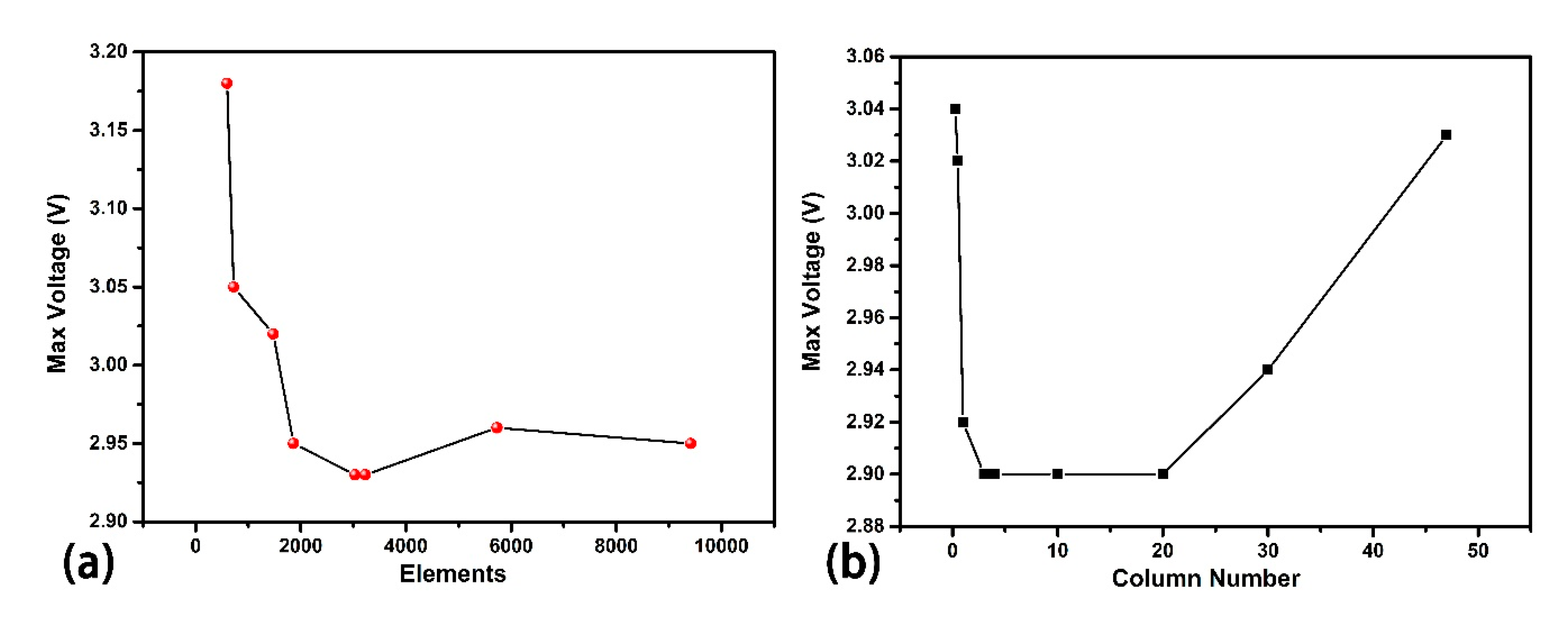

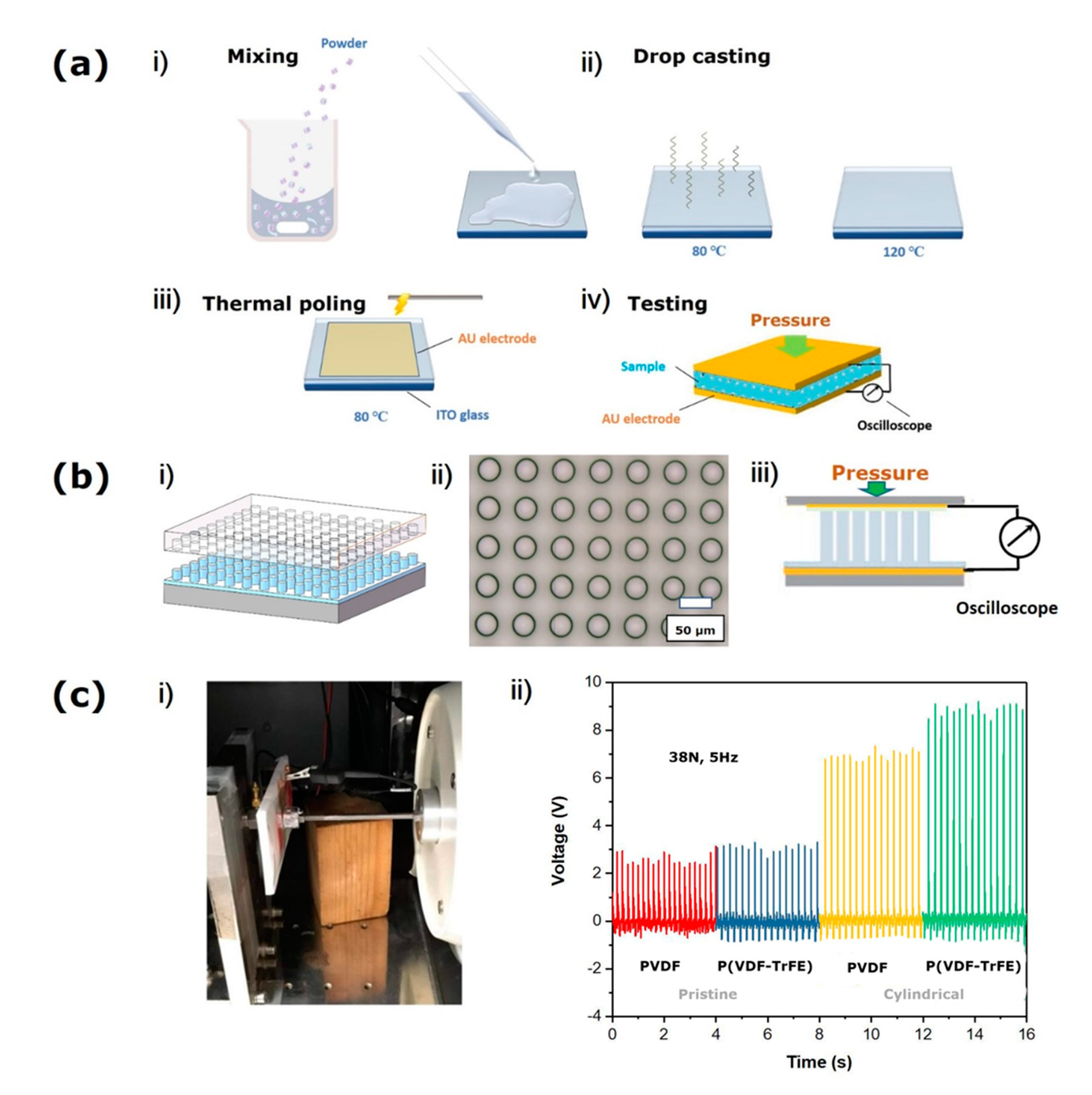
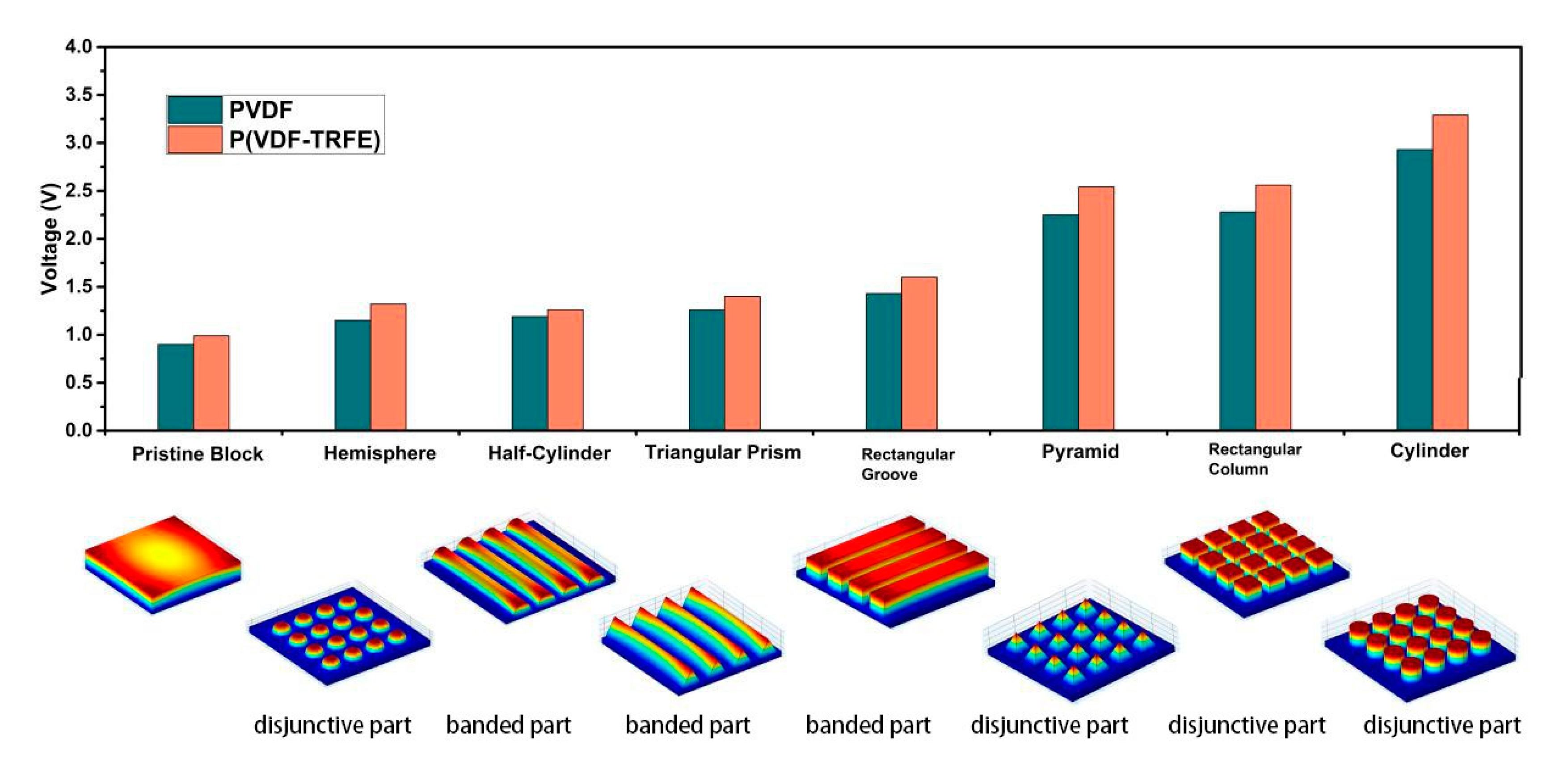
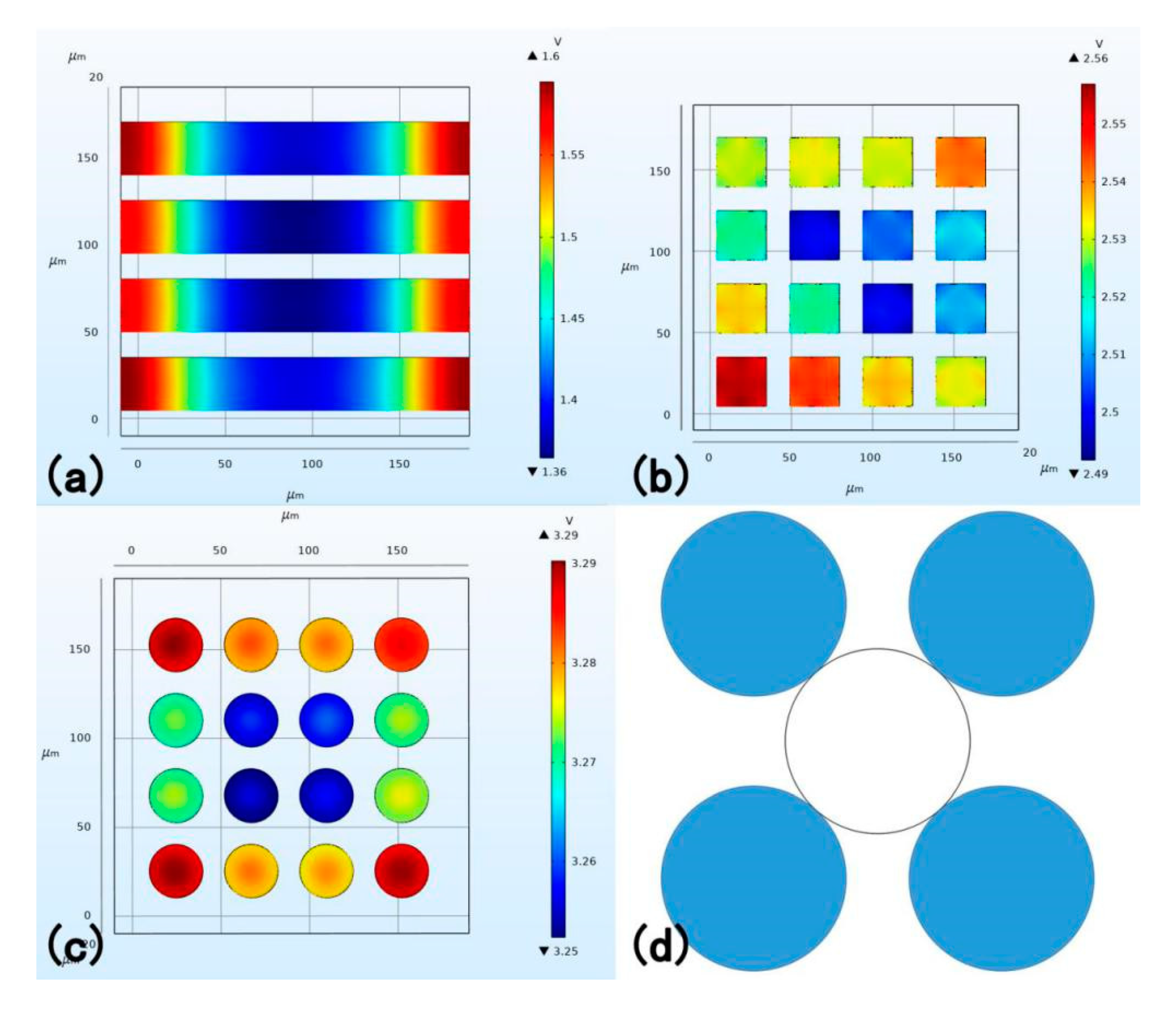
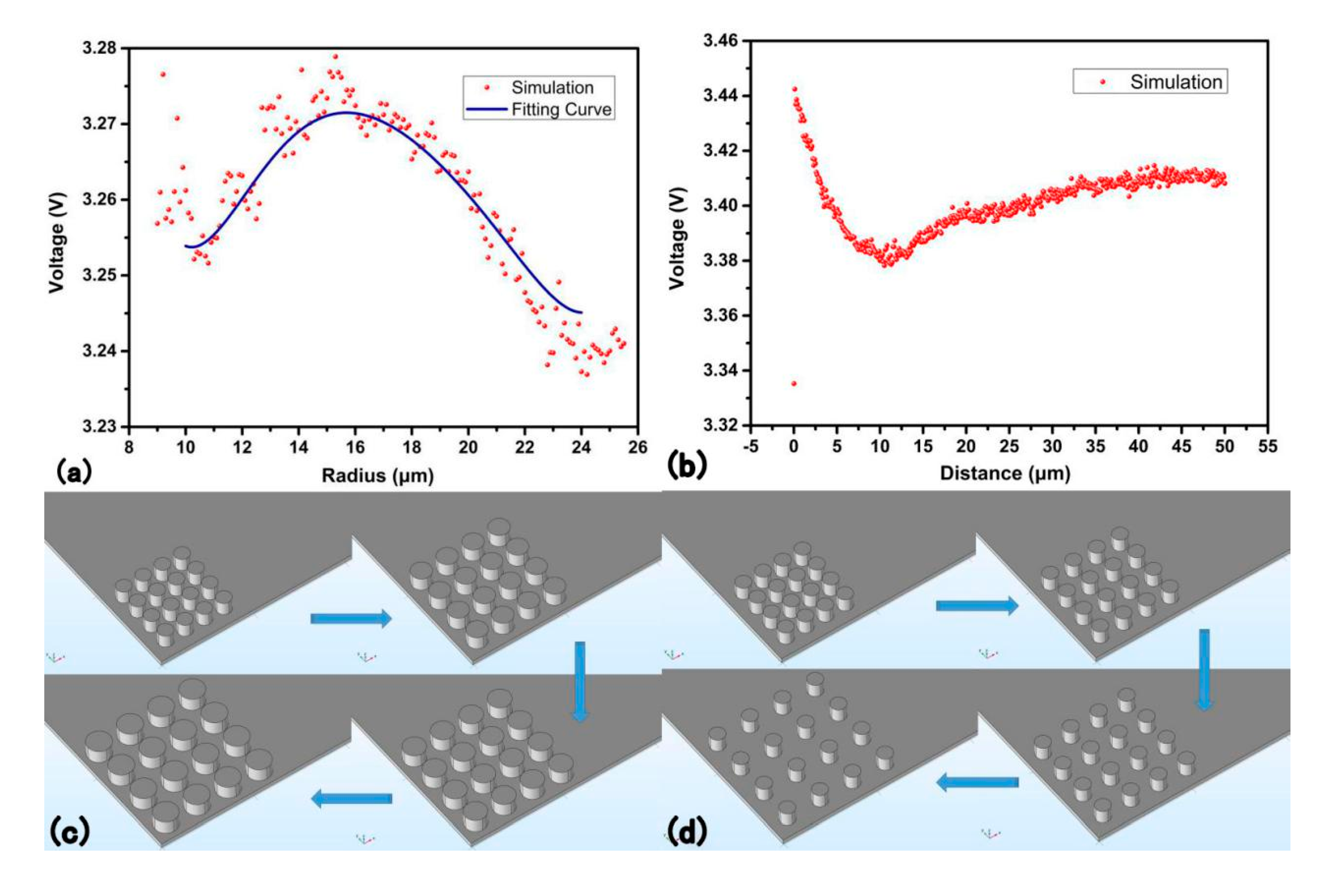
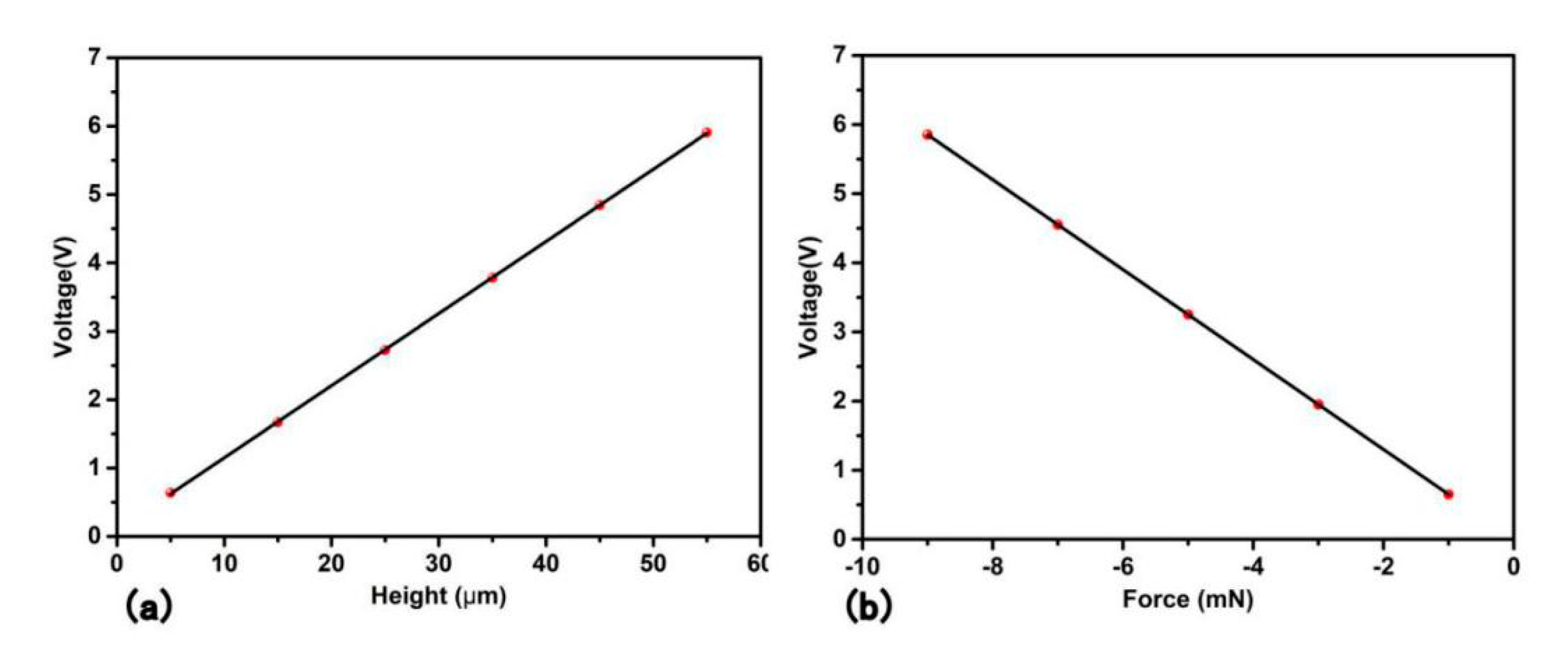

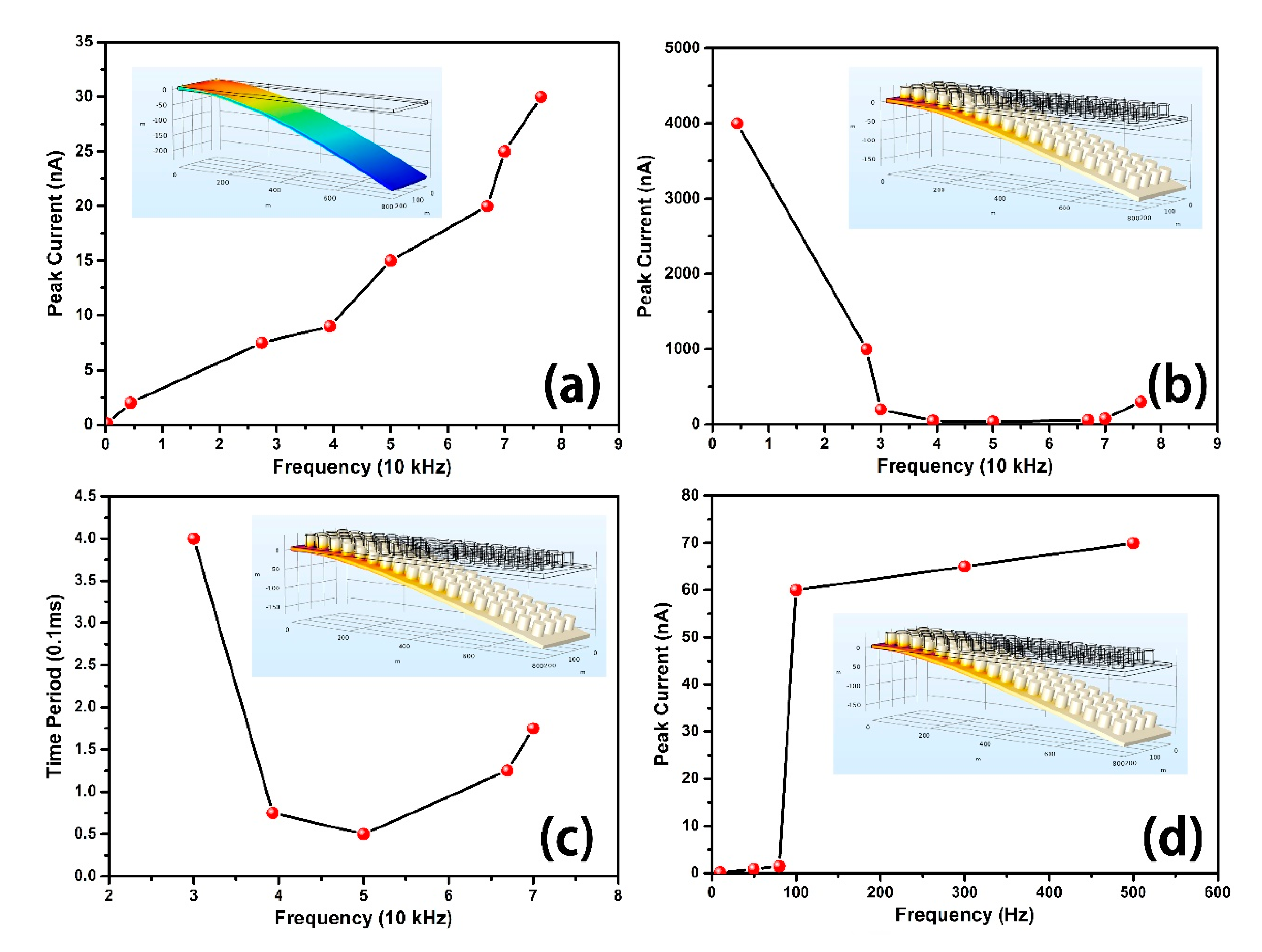



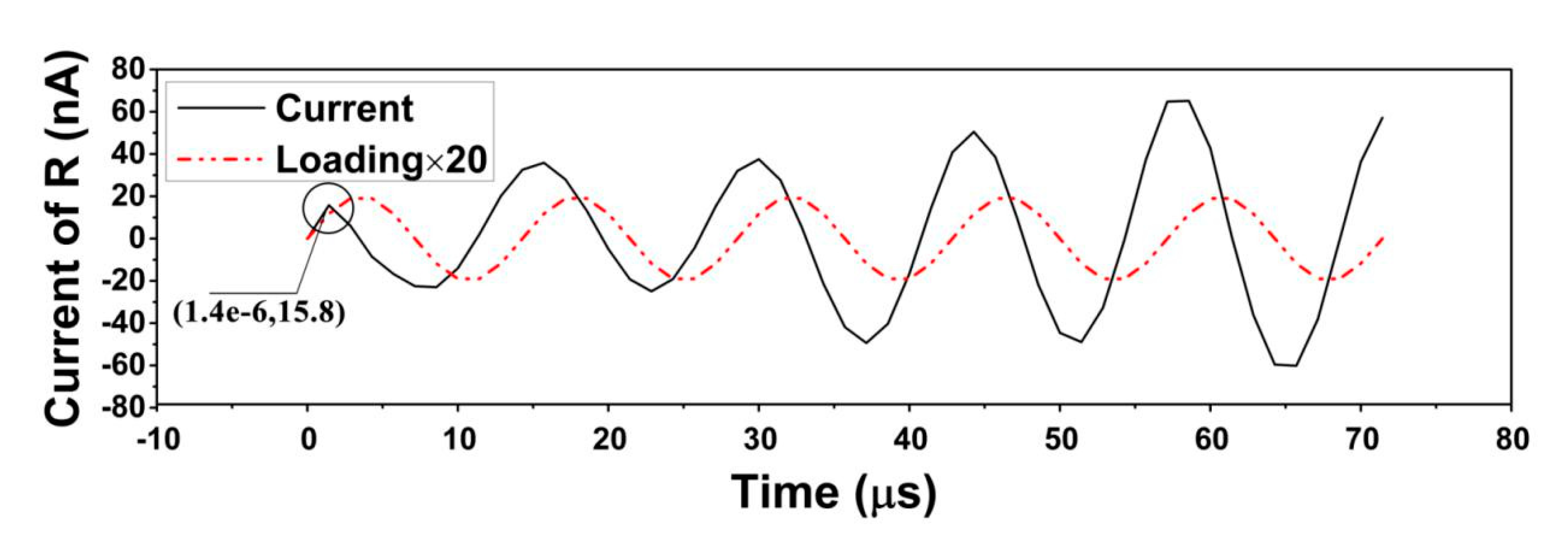
| 1 | 2 | 3 | 4 | 5 | 6 | 7 | 8 | |
|---|---|---|---|---|---|---|---|---|
| High-Frequency Group (Hz) | 4398 | 27,438 | 30,000 | 39,325 | 50,000 | 66,926 | 70,000 | 76,376 |
| Low-Frequency Group (Hz) | 10 | 50 | 80 | 100 | 300 | 500 |
| Piezoelectric Materials | Key Parameters | Resonant Frequency | Output Power (per Area) | Output Power (per Voltage) | |
|---|---|---|---|---|---|
| This work | P(VDF-TrFE) | Length = 200 μm; Width = 800 μm; Thickness = 10 μm; | 4398 Hz | 1 × 10−2 W/m2 | 1 × 103 W/m3 |
| Work 1 [48] | PZT | Length = 3 mm; Width = 5 mm; | 618 Hz | 6.267 × 10−3 W/m2 | |
| Work 2 [49] | PZT | Length = 13.5 mm; Width = 9 mm; Thickness = 192 μm; | 229 Hz | 0.0114 × 103 W/m3 | |
| Work 3 [50] | PZT | Length = 3000 μm; Width = 1500 μm; Thickness = 22 μm; | 575 Hz | 0.4758 × 103 W/m3 | |
| Work 4 [51] | PZT | Length = 1600 μm; Width = 400 μm; Thickness = 30 μm; | 0.1 × 103 W/m3 | ||
| Work 5 [35] | P(VDF-TrFE) | Length = 1000 μm; Width = 300 μm; Thickness = 2.5 μm; | 477.03 Hz | 0.24992 × 103 W/m3 |
Publisher’s Note: MDPI stays neutral with regard to jurisdictional claims in published maps and institutional affiliations. |
© 2020 by the authors. Licensee MDPI, Basel, Switzerland. This article is an open access article distributed under the terms and conditions of the Creative Commons Attribution (CC BY) license (http://creativecommons.org/licenses/by/4.0/).
Share and Cite
Liu, Y.; Huang, Z.; Liu, C. Improved Design via Simulation of Micro-Modified PVDF and Its Copolymer Energy Harvester with High Electrical Outputs. Sensors 2020, 20, 5834. https://doi.org/10.3390/s20205834
Liu Y, Huang Z, Liu C. Improved Design via Simulation of Micro-Modified PVDF and Its Copolymer Energy Harvester with High Electrical Outputs. Sensors. 2020; 20(20):5834. https://doi.org/10.3390/s20205834
Chicago/Turabian StyleLiu, Yizhi, Ziyu Huang, and Chen Liu. 2020. "Improved Design via Simulation of Micro-Modified PVDF and Its Copolymer Energy Harvester with High Electrical Outputs" Sensors 20, no. 20: 5834. https://doi.org/10.3390/s20205834
APA StyleLiu, Y., Huang, Z., & Liu, C. (2020). Improved Design via Simulation of Micro-Modified PVDF and Its Copolymer Energy Harvester with High Electrical Outputs. Sensors, 20(20), 5834. https://doi.org/10.3390/s20205834





